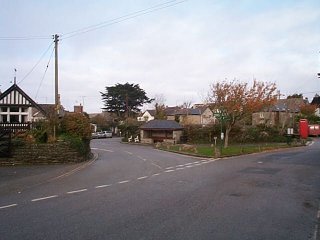
Crantock is the site of an altogether much older settlement - Langurroc, which means the 'dwelling of the monks'.
A college was founded here which could claim as much antiquity as any college in Oxford, since it appeared to have had great revenues in the Survey of 1294. It closed in 1545.
The Celtic monastery was established before the Norman conquest. At the coming of the Normans it was seized by the Count of Montain, whose son gave it to the Montacute Priory in Dorset in 1230.
The city of Langurroc or Langarrow was an ancient city of great wealth and importance, with several churches and some rich inhabitants. Criminals were transported from other parts of Britain to work in the mines here. They were not allowed to dwell in the city, but lived in wooden huts or in caves. Evidence has been found of wood ashes, also the shells of mussels and cockles which were their food. The eventual intermarriage of the convicts with the citizens' daughters caused the population to sink to the lowest depths of vice.
Legend says the anger of the Lord fell upon them, and a sandstorm was made to blow for three days and nights, which completely blotted out the city and its wicked inhabitants.
This burying of the old city is one of the legends of Crantock. It is curious that the church of St. Enodoc to the east and St. Piran to the west have been dug out of the sand. It is significant that Marram grass was only introduced into Europe by Sir Walter Raleigh. Without its stabilising influence. the legend, as far as the sand is concerned, may have some foundation.
Today we believe that Crantock was founded by St. Carantacus in the 5th century. The son of a Welsh chieftain, he went to Ireland where he met St. Patrick, and they studied together. They went their separate ways and St. Carantoc (as he was now known) came to Cornwall in his 'coracle' (which was presumably an Irish 'currah', or leather skinned, long open canoe) in which he brought an altar stone and a pet dove, and he came to rest in the Gannel. The dove picked up a stick in its beak, and upon the spot where it dropped the stick St. Carantoc established his church; the present church is upon the same site.
The arrival of St. Carantoc has been celebrated through the ages on his Saint's Day, 16th May. In medieval times seven chapels (probably little shrines) existed. All the churches around brought their relies and put them on the altars, and masses were said all day on the Feast Day.
The people may well have used the original route of the monks travelling to the college of Crantock, by following the local crosses or cross-way markers. There are 5 well-known crosses:- at Penpol, at Trevemper (both of these have their original bases in place), at Tolcarne, at Trerew, and at Doublestiles.
In more modern times Feast Day has been celebrated with greater exuberance. On 16th May 1721, William Coombs of St. Agnes, twenty years old, was drinking with others in the Ship Inn (now Meadow Bank Farm) when he was shot by one of his friends. He was buried in Crantock Churchyard on the 17th May, apparently without an inquest. The incident is recorded in a folk song entitled 'Crantock Games', a great favourite by singer Benjamin Luxon.
Today, Feast Day has developed into a 'Feast Week' with events nearly every day, a Mass on the Feast Day itself, and a public celebration on the Feast Week Saturday with competitions, and a fancy dress parade led by a band through the village, culminating in a Feast Tea in the Village Hall.
Crantock Beach Crantock Village The Parish Church of St. Carantoc The Old Albion Inn